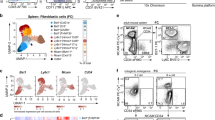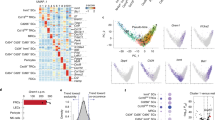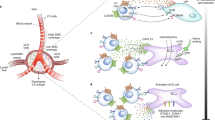Abstract
Lymph node stromal cells (LNSCs) closely regulate immunity and self-tolerance, yet key aspects of their biology remain poorly elucidated. Here, comparative transcriptomic analyses of mouse LNSC subsets demonstrated the expression of important immune mediators, growth factors and previously unknown structural components. Pairwise analyses of ligands and cognate receptors across hematopoietic and stromal subsets suggested a complex web of crosstalk. Fibroblastic reticular cells (FRCs) showed enrichment for higher expression of genes relevant to cytokine signaling, relative to their expression in skin and thymic fibroblasts. LNSCs from inflamed lymph nodes upregulated expression of genes encoding chemokines and molecules involved in the acute-phase response and the antigen-processing and antigen-presentation machinery. Poorly studied podoplanin (gp38)-negative CD31− LNSCs showed similarities to FRCs but lacked expression of interleukin 7 (IL-7) and were identified as myofibroblastic pericytes that expressed integrin α7. Together our data comprehensively describe the transcriptional characteristics of LNSC subsets.
This is a preview of subscription content, access via your institution
Access options
Subscribe to this journal
Receive 12 print issues and online access
$209.00 per year
only $17.42 per issue
Buy this article
- Purchase on SpringerLink
- Instant access to full article PDF
Prices may be subject to local taxes which are calculated during checkout








Similar content being viewed by others
Accession codes
References
Heng, T.S. & Painter, M.W. The Immunological Genome Project: networks of gene expression in immune cells. Nat. Immunol. 9, 1091–1094 (2008).
Link, A. et al. Fibroblastic reticular cells in lymph nodes regulate the homeostasis of naive T cells. Nat. Immunol. 8, 1255–1265 (2007).
Fletcher, A.L., Malhotra, D. & Turley, S.J. Lymph node stroma broaden the peripheral tolerance paradigm. Trends Immunol. 32, 12–18 (2011).
Lee, J.W. et al. Peripheral antigen display by lymph node stroma promotes T cell tolerance to intestinal self. Nat. Immunol. 8, 181–190 (2007).
Gardner, J.M. et al. Deletional tolerance mediated by extrathymic Aire-expressing cells. Science 321, 843–847 (2008).
Fletcher, A.L. et al. Lymph node fibroblastic reticular cells directly present peripheral tissue antigen under steady-state and inflammatory conditions. J. Exp. Med. 207, 689–697 (2010).
Cohen, J.N. et al. Lymph node-resident lymphatic endothelial cells mediate peripheral tolerance via Aire-independent direct antigen presentation. J. Exp. Med. 207, 681–688 (2010).
Pham, T.H. et al. Lymphatic endothelial cell sphingosine kinase activity is required for lymphocyte egress and lymphatic patterning. J. Exp. Med. 207, 17–27 (2010).
Sixt, M. et al. The conduit system transports soluble antigens from the afferent lymph to resident dendritic cells in the T cell area of the lymph node. Immunity 22, 19–29 (2005).
Roozendaal, R., Mebius, R.E. & Kraal, G. The conduit system of the lymph node. Int. Immunol. 20, 1483–1487 (2008).
Palframan, R.T. et al. Inflammatory chemokine transport and presentation in HEV: a remote control mechanism for monocyte recruitment to lymph nodes in inflamed tissues. J. Exp. Med. 194, 1361–1373 (2001).
Itano, A.A. et al. Distinct dendritic cell populations sequentially present antigen to CD4 T cells and stimulate different aspects of cell-mediated immunity. Immunity 19, 47–57 (2003).
Kalluri, R. & Zeisberg, M. Fibroblasts in cancer. Nat. Rev. Cancer 6, 392–401 (2006).
Link, A. et al. Association of T-zone reticular networks and conduits with ectopic lymphoid tissues in mice and humans. Am. J. Pathol. 178, 1662–1675 (2011).
Reich, M. et al. GenePattern 2.0. Nat. Genet. 38, 500–501 (2006).
Huang, W.W., Sherman, B.T. & Lempicki, R. A. Systematic and integrative analysis of large gene lists using DAVID bioinformatics resources. Nat. Protoc. 4, 44–57 (2009).
Mackay, F. & Leung, H. The role of the BAFF/APRIL system on T cell function. Semin. Immunol. 18, 284–289 (2006).
Wei, S. et al. Functional overlap but differential expression of CSF-1 and IL-34 in their CSF-1 receptor-mediated regulation of myeloid cells. J. Leukoc. Biol. 88, 495–505 (2010).
Watowich, S.S. & Liu, Y.J. Mechanisms regulating dendritic cell specification and development. Immunol. Rev. 238, 76–92 (2010).
Chyou, S. et al. Fibroblast-type reticular stromal cells regulate the lymph node vasculature. J. Immunol. 181, 3887–3896 (2008).
Liston, A. et al. Inhibition of CCR6 function reduces the severity of experimental autoimmune encephalomyelitis via effects on the priming phase of the immune response. J. Immunol. 182, 3121–3130 (2009).
Kalamajski, S. & Oldberg, A. The role of small leucine-rich proteoglycans in collagen fibrillogenesis. Matrix Biol. 29, 248–253 (2010).
Schvartz, I., Seger, D. & Shaltiel, S. Vitronectin. Int. J. Biochem. Cell Biol. 31, 539–544 (1999).
van den Berg, T.K., van der Ende, M., Dopp, E.A., Kraal, G. & Dijkstra, C.D. Localization of beta 1 integrins and their extracellular ligands in human lymphoid tissues. Am. J. Pathol. 143, 1098–1110 (1993).
Page-McCaw, A., Ewald, A.J. & Werb, Z. Matrix metalloproteinases and the regulation of tissue remodelling. Nat. Rev. Mol. Cell Biol. 8, 221–233 (2007).
Chang, S.K., Gu, Z. & Brenner, M.B. Fibroblast-like synoviocytes in inflammatory arthritis pathology: the emerging role of cadherin-11. Immunol. Rev. 233, 256–266 (2010).
Moll, R. et al. Endothelial and virgultar cell formations in the mammalian lymph node sinus: endothelial differentiation morphotypes characterized by a special kind of junction (complexus adhaerens). Cell Tissue Res. 335, 109–141 (2009).
Yamamura, H., Hirano, N., Koyama, H., Nishizawa, Y. & Takahashi, K. Loss of smooth muscle calponin results in impaired blood vessel maturation in the tumor-host microenvironment. Cancer Sci. 98, 757–763 (2007).
Mayer, U. et al. Absence of integrin α7 causes a novel form of muscular dystrophy. Nat. Genet. 17, 318–323 (1997).
Fitzgerald, K.A. et al. LPS-TLR4 signaling to IRF-3/7 and NF-κB involves the toll adapters TRAM and TRIF. J. Exp. Med. 198, 1043–1055 (2003).
Khan, K.D., Lindwall, G., Maher, S.E. & Bothwell, A.L. Characterization of promoter elements of an interferon-inducible Ly-6E/A differentiation antigen, which is expressed on activated T cells and hematopoietic stem cells. Mol. Cell. Biol. 10, 5150–5159 (1990).
Li, C. & Chan, Y.R. Lipocalin 2 regulation and its complex role in inflammation and cancer. Cytokine 56, 435–441 (2011).
Fontaine, C. et al. The nuclear receptor Rev-erbα is a liver X receptor (LXR) target gene driving a negative feedback loop on select LXR-induced pathways in human macrophages. Mol. Endocrinol. 22, 1797–1811 (2008).
Young, B.B., Gordon, M.K. & Birk, D.E. Expression of type XIV collagen in developing chicken tendons: association with assembly and growth of collagen fibrils. Dev. Dyn. 217, 430–439 (2000).
Danielson, K.G. et al. Targeted disruption of decorin leads to abnormal collagen fibril morphology and skin fragility. J. Cell Biol. 136, 729–743 (1997).
Bailey, A.J. Molecular mechanisms of ageing in connective tissues. Mech. Ageing Dev. 122, 735–755 (2001).
Gilbert, D.L., Okano, T., Miyata, T. & Kim, S.W. Macromolecular diffusion through collagen membranes. Int. J. Pharm. 47, 79–88 (1988).
Brennan, K. & Bowie, A.G. Activation of host pattern recognition receptors by viruses. Curr. Opin. Microbiol. 13, 503–507 (2010).
Brass, A.L. et al. The IFITM proteins mediate cellular resistance to influenza A H1N1 virus, West Nile virus, and dengue virus. Cell 139, 1243–1254 (2009).
Mueller, S.N. et al. Viral targeting of fibroblastic reticular cells contributes to immunosuppression and persistence during chronic infection. Proc. Natl. Acad. Sci. USA 104, 15430–15435 (2007).
Tomei, A.A., Siegert, S., Britschgi, M.R., Luther, S.A. & Swartz, M.A. Fluid flow regulates stromal cell organization and CCL21 expression in a tissue-engineered lymph node microenvironment. J. Immunol. 183, 4273–4283 (2009).
Lämmermann, T. & Sixt, M. The microanatomy of T-cell responses. Immunol. Rev. 221, 26–43 (2008).
Chang, S.K. et al. Cadherin-11 regulates fibroblast inflammation. Proc. Natl. Acad. Sci. USA 108, 8402–8407 (2011).
Kenins, L., Gill, J.W., Boyd, R.L., Hollander, G.A. & Wodnar-Filipowicz, A. Intrathymic expression of Flt3 ligand enhances thymic recovery after irradiation. J. Exp. Med. 205, 523–531 (2008).
Roozendaal, R. et al. Conduits mediate transport of low-molecular-weight antigen to lymph node follicles. Immunity 30, 264–276 (2009).
Mitola, S. et al. Gremlin is a novel agonist of the major proangiogenic receptor VEGFR2. Blood 116, 3677–3680 (2010).
Fisher, L.W., Stubbs, J.T. III & Young, M.F. Antisera and cDNA probes to human and certain animal model bone matrix noncollagenous proteins. Acta Orthop. Scand. Suppl. 266, 61–65 (1995).
Fletcher, A. et al. Reproducible isolation of lymph node stromal cells reveals site-dependent differences in fibroblastic reticular cells. Front. Immunol. 2, 35 (2011).
Painter, M.W., Davis, S., Hardy, R.R., Mathis, D. & Benoist, C. Transcriptomes of the B and T lineages compared by multiplatform microarray profiling. J. Immunol. 186, 3047–3057 (2011).
Gonzalez, S.F Capture of influenza by medullary dendritic cells via SIGN-R1 is essential for humoral immunity in draining lymph nodes. Nat. Immunol. 11 427–434 (2011).
Acknowledgements
We thank L. Fisher (US National Institutes of Health) for polyclonal anti-decorin, anti-fibromodulin and anti-biglycan; M. Koch (University of Cologne) for polyclonal anti–collagen XIV; M. Curry for technical assistance in sorting stromal-cell populations; J.B. Lewis for discussions during analysis of microarray data; eBioscience, Affymetrix and Expression Analysis for support of the ImmGen Project; and K.W. Wucherpfennig for critical reading of the manuscript. Supported by the US National Institutes of Health (R01 DK074500 and P01 AI045757 to S.J.T.; R24 AI072073 to the ImmGen Consortium; R01 AI063428-06 to M.B.B.; R01 DE019917 to D.J.M.; and GM38903 to M.E.H. and K.K.), the Dana-Farber Cancer Institute (K.K. and V.L.-K.) and the Seventh Framework Programme of the European Union (Marie Curie International Outgoing Fellowship 220044 to S.F.G.).
Author information
Authors and Affiliations
Consortia
Contributions
D.M. and A.L.F. designed the study, did and analyzed most experiments, and wrote the manuscript; S.J.T. designed and directed the study, analyzed and interpreted results, and wrote the manuscript; D.M. did primary analysis of the microarray data; V.L.-K., P.T., S.F.G., J.A., K.G.E. and K.K. did and analyzed individual experiments; and S.K.C., M.B.B., D.J.M., M.C.C. and M.E.H. contributed reagents and assisted with the analysis of individual experiments.
Corresponding author
Ethics declarations
Competing interests
The authors declare no competing financial interests.
Supplementary information
Supplementary Text and Figures
Supplementary Figures 1–13 (PDF 14334 kb)
Supplementary Note 1
Supplementary Note 1 (PDF 3371 kb)
Table 1
Table 1 (XLSX 229 kb)
Table 2
Table 2 (XLSX 216 kb)
Table 3
Table 3 (XLSX 284 kb)
Table 4
Table 4 (XLSX 49 kb)
Table 5
Table 5 (XLSX 37 kb)
Note 2
Note 2 (XLSX 251 kb)
Rights and permissions
About this article
Cite this article
Malhotra, D., Fletcher, A., Astarita, J. et al. Transcriptional profiling of stroma from inflamed and resting lymph nodes defines immunological hallmarks. Nat Immunol 13, 499–510 (2012). https://doi.org/10.1038/ni.2262
Received:
Accepted:
Published:
Issue Date:
DOI: https://doi.org/10.1038/ni.2262



